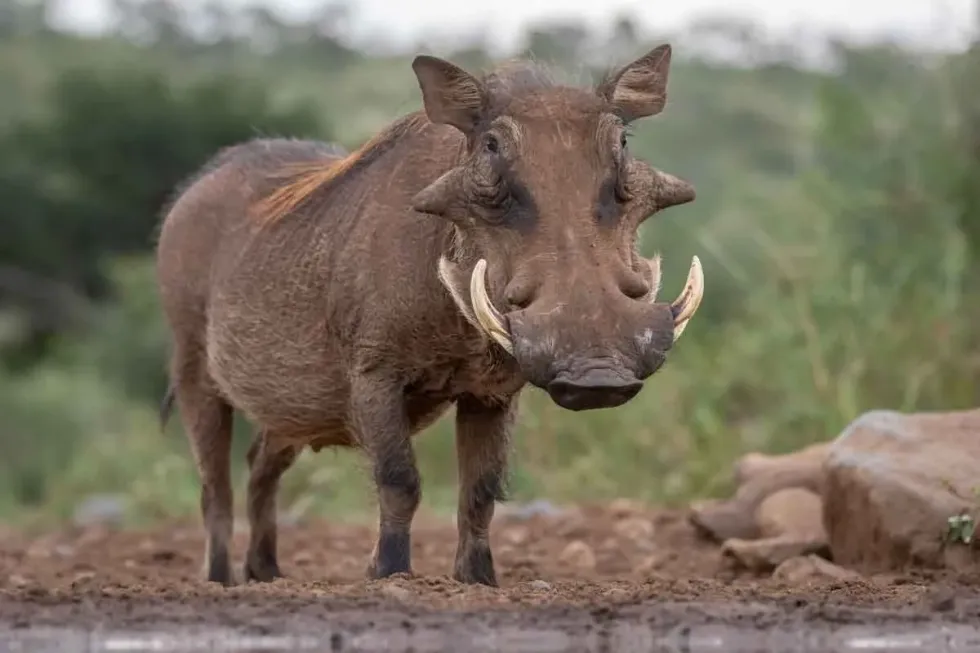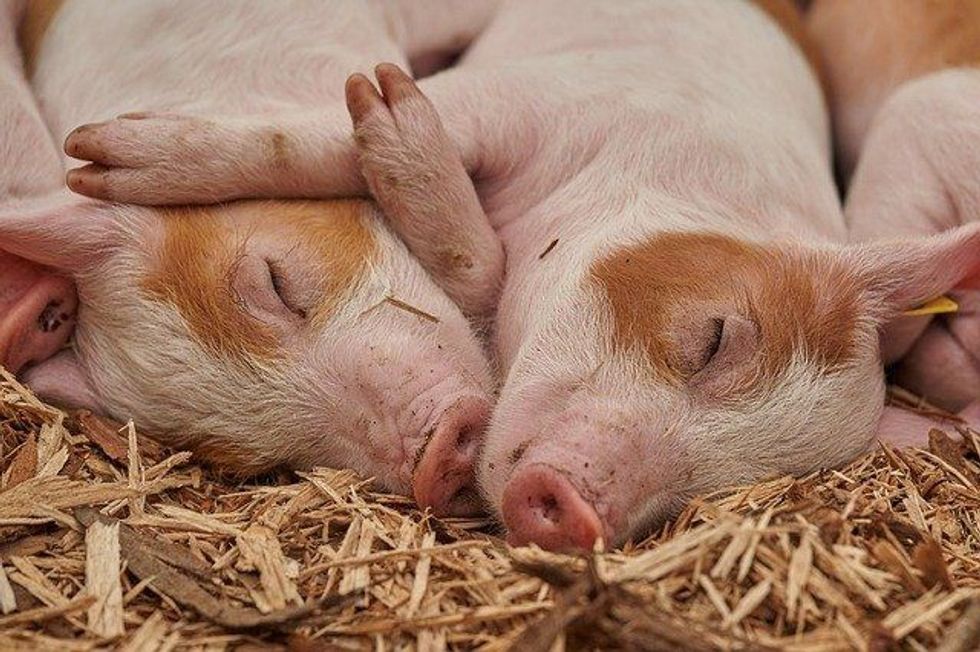A common warthog, Phacochoerus africanus, is a member of the Swine family and is similar to domestic pigs and boars. Warthogs are majorly popular for their very adaptable nature, and so they are found both in grasslands and deserts.
Warthogs or Phacochoerus Africanus have a hooved and barrel-shaped body with padded bumps. They have four tusks, thick mane, little tufted tails, warts, and have a large head. Apparently, they are called warthogs because they have protrusions called 'warts' on the side of their face.
Phacochoerus aethiopicus are warthogs that are found in deserts or arid regions.
Desert warthog, Phacochoerus aethiopicus are generally found in sub-Saharan Africa and Northern Kenya and in other parts of Africa such as Ethiopia and Somalia; these became extinct in South Africa back in 1865 but are now in abundance.
Common warthogs are found in open savannas and woodlands in the Kruger National Park and in other areas of East and South Africa.
Female warthogs are known as sows and are generally found in groups called sounders, where female warthogs and their young ones usually join together and groom and share warmth together whereas males are not social and they do not join together in groups.
Warthogs are often considered ferocious and attack animals, but usually, warthogs are grazers and are not aggressive, and so they do not fight. Warthogs are herbivores, but in times of scarcity and the dry season, they scavenge on dead animals and insects, but they never go for a hunt. And in wildlife, warthogs are popular prey for many predators.
To know more about these fascinating animals, we have gathered a set of interesting facts about them for you to read.
Warthog Interesting Facts
What type of animal is a warthog?
Warthogs belong to the domestic pig family called Suidae.
What class of animal does a warthog belong to?
Warthog Phacochoerus africanus belongs to the class of mammals or Mammalia.
How many warthog are there in the world?
Warthogs have a high reproductive rate that makes them locally abundant and widespread, especially in South Africa. The estimated number of warthogs in South Africa is 250,000.
The densities of warthogs depend on the habitat, so typically, the number ranges from one-ten per km square but near short grasses and grasslands, it is 77 per km square. However, there is no such authentic data calculated about the distribution of warthogs alive in the world.
Where does a warthog live?
Warthogs are really adaptable, and so they can withstand any environment, but majorly warthogs live in savanna and woodlands. Warthogs do not fight for burrows and holes as they are passive. Though warthogs are amazing diggers, they rarely dig their own burrows to live.Rather they search for abandoned dens made by aardvarks to settle in.
What is a warthog's habitat?
Common warthogs prefer grass and open areas, and so they are found at the height of 3000 meters on Mount Kilimanjaro. At the same time, desert warthogs, or Phacochoerus aethiopicus, are found in deserts or arid areas of Africa such as Kenya and Ethiopia. Moreover, they do dig and eat bulbs and tubers during the dry season.
Who do warthog live with?
Warthogs generally live in groups of adults and young warthogs. Female warthogs join groups called sounders and are socially active; on the other hand, males live alone and are not social.
How long does a warthog live?
Warthogs generally have an average lifespan of about 12-18 years. They have a life expectancy of around 12-15 years in the bushes or wild, but they can increase up to 20 years in captivity.
How do they reproduce?
Warthogs have high reproductive rates, and common warthogs breed seasonally and once a year. Warthogs, both female and male, may have many mates, and so they are polygamous.
In warthogs, rutting usually begins after the rainy season, and they have a gestation period of five to six months, where the sows separate from their families and move to different holes. The litter is generally one to eight piglets, with the average being three piglets per litter.
Warthogs cannot be bred with pigs, and there is no such evidence of interbreeding. Warthogs' puberty is achieved at six-seven months for females and seven-nine months for males.
What is their conservation status?
The conservation status of warthogs is listed as Least Concern in the IUCN, International Union for Conservation of Nature. South Africa has around 250,000 warthogs and this is largely multiplying in South Africa.
Typically the number of warthogs is from 1-10 per km square, but the density increases near roots and grasslands and short grasses such as in Nakuru National Park, the density is 77 warthogs per km square.
Warthog Fun Facts
What do warthogs look like?

Warthogs are hooved with four tusks that are protruded and enlarged part of the canine teeth, a large head covered with warts, which is actually there to protect them. They are brownish-black colored animals and have huge nostrils.
Their tusks and snouts help them in digging holes, burrows, and bulbs. Warthogs are hairless, but they have hairy manes at the end of their back and tiny tails.
How cute are they?
Warthogs are pleasing and considered to be the most captivating African prey, with various predators preying on them. Yet, they can be unpredictable and dangerous. They aren't particularly cute, but are endearing.
How do they communicate?
Warthogs are social creatures except for the males. Moreover, they use several sounds and a range of vocals to convey and greet each other. Female warthogs have a matriarchal group known as sounders which include around 40 sows and piglets. They use growls, grunts, squeals, and snorts to greet, warn or convey anything.
How big is a warthog?
Warthogs are huge and have a length of 35-48 in (90-150 cm) from hooves to rump, and have a height of (25-33 in) 63.5-85 cm. Common warthogs are generally bigger than desert warthogs. They are mainly of the same size as that of domestic pigs but are one-third times smaller than wild boars.
How fast can a warthog move?
Warthogs are really skilled at running. They can run 30 miles per hour when threatened or startled. Warthogs are great runners, which helps them escape and run away from predators and enemies.
How much does a warthog weigh?
Warthogs weight ranges from 110-330 lb (50-150 kg). Females weigh slightly lesser than males, and hence females are lighter and smaller than males.
What are their male and female names of the species?
Female warthogs are called sows, whereas male warthogs are known as boars.
What would you call a baby warthog?
Baby warthogs are known as piglets.
What do they eat?
Warthogs diet includes roots, berries, grasses, tubers, and sometimes insects, bugs. Warthogs are basically grazers, and in times of scarcity, they scavenge dead insects and bugs.
Are they dangerous?
Warthogs are dangerous as they have four pointed tusks, but they are not aggressive; therefore they pose no harm or threats to humans physically unless startled.
Would they make a good pet?
Warthogs are really captivating, but in several places, it is illegal to own warthogs as pets. They are very unpredictable and have huge tusks, so they might cause harm.
Did you know...
Warthogs have this bizarre habit of kneeling on their front knees during foraging a localized area or feeding.
Although warthogs are herbivores and they prefer grasses in their diet, they do eat meat and dead insects or animals, but they never hunt them themselves.
Warthogs are skilled swimmers, and they usually rest in shallow waters or mud to protect themselves from insects and sunburn.
Warthogs are diurnal that is they are most active during the day, and they spend most of the time searching for food during the day, but they can switch to nocturnal which is being active and foraging during the night in case there are some disturbances or threats.
Is The Warthog Endangered?
Warthogs are not perceived as endangered species, but still, there are threats to the life of warthogs as they are hunted by poachers for tusks and meat.
Different Types Of Warthogs
Warthogs are further classified into two types, namely common warthogs and desert warthogs.
Here at Kidadl, we have carefully created lots of interesting family-friendly animal facts for everyone to discover! You can even occupy yourself at home by drawing one on our pig coloring pages.









